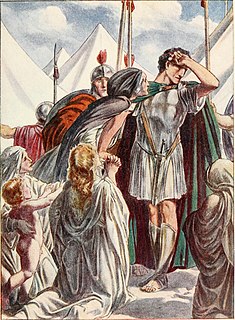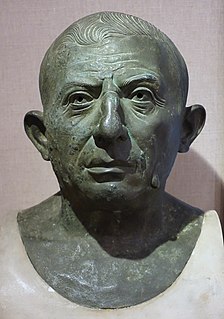Related Research Articles
This article concerns the period 69 BC – 60 BC.
Year 59 BC was a year of the pre-Julian Roman calendar. At the time, it was known as the Year of the Consulship of Caesar and Bibulus. The denomination 59 BC for this year has been used since the early medieval period, when the Anno Domini calendar era became the prevalent method in Europe for naming years.
This article concerns the period 139 BC – 130 BC.
Year 60 BC was a year of the pre-Julian Roman calendar. At the time, it was known as the Year of the Consulship of Metellus and Afranius. The denomination 60 BC for this year has been used since the early medieval period, when the Anno Domini calendar era became the prevalent method in Europe for naming years.
Year 62 BC was a year of the pre-Julian Roman calendar. At the time it was known as the Year of the Consulship of Silanus and Murena. The denomination 62 BC for this year has been used since the early medieval period, when the Anno Domini calendar era became the prevalent method in Europe for naming years.
Year 63 BC was a year of the pre-Julian Roman calendar. At the time it was known as the Year of the Consulship of Cicero and Hybrida. The denomination 63 BC for this year has been used since the early medieval period, when the Anno Domini calendar era became the prevalent method in Europe for naming years.
Year 68 BC was a year of the pre-Julian Roman calendar. At the time it was known as the Year of the Consulship of Metellus/Vatia and Rex. The denomination 68 BC for this year has been used since the early medieval period, when the Anno Domini calendar era became the prevalent method in Europe for naming years.
Year 123 BC was a year of the pre-Julian Roman calendar. At the time it was known as the Year of the Consulship of Balearicus and Flamininus and the Sixth Year of Yuanshuo. The denomination 123 BC for this year has been used since the early medieval period, when the Anno Domini calendar era became the prevalent method in Europe for naming years.
Year 115 BC was a year of the pre-Julian Roman calendar. At the time it was known as the Year of the Consulship of Scaurus and Metellus. The denomination 115 BC for this year has been used since the early medieval period, when the Anno Domini calendar era became the prevalent method in Europe for naming years.

The Caecilii Metelli, one of the most important and wealthy families in the Roman Republic, came of noble stock. The Caecilii Metelli, part of the gens Caecilia, remained a political power within the state from the 3rd century BC to the end of the Republic in the 1st century BC, holding every office in the cursus honorum as well as several important military commands.
Quintus Caecilius Metellus Numidicus was an ancient Roman statesman and general, he was a leader of the Optimates, the conservative faction of the Roman Senate. He was a bitter political opponent of Gaius Marius. He was consul in 109 BC, in that capacity he commanded the Roman forces in Africa during the Jugurthine War. In 107 BC he was displaced from his command by Marius. On his return he was granted a triumph and the cognomen Numidicus. He later became a censor, entering into exile in opposition to Marius. Metellus Numidicus enjoyed a reputation for integrity in an era when Roman politics was increasingly corrupt.
Quintus Caecilius Metellus Macedonicus was a Praetor in 148 BC, Consul in 143 BC, Proconsul of Hispania Citerior in 142 BC and Censor in 131 BC.
Quintus Caecilius Metellus Pius was a Roman politician and general. Like the other members of the influential Caecilii Metelli family, he was a leader of the Optimates, the conservative faction opposed to the Populares during the last century of the Roman Republic.

The gens Marcia, occasionally written Martia, was one of the oldest and noblest houses at ancient Rome. They claimed descent from the second and fourth Roman Kings, and the first of the Marcii appearing in the history of the Republic would seem to have been patrician; but all of the families of the Marcii known in the later Republic were plebeian. The first to obtain the consulship was Gaius Marcius Rutilus in 357 BC, only a few years after the passage of the lex Licinia Sextia opened this office to the plebeians.
Quintus Caecilius Metellus Celer, son of Quintus Caecilius Metellus Nepos, or, according to some, the son of tribune Quintus Caecilius Metellus Celer while the latter is the son of Quintus Caecilius Metellus Nepos, was an ancient Roman statesman and general during the First Century BC. He became consul in 60 BC and previously he held the offices of praetor and augur.
Lucius Caecilius Metellus was a Roman aristocrat. He was praetor in 71 BC. He succeeded Gaius Verres as governor of Sicily in 70 BC. He died in office as consul in 68 BC. His co-consul was Quintus Marcius Rex.
Gaius Caecilius Metellus Caprarius was a consul of the Roman Republic in 113 BC with Gnaeus Papirius Carbo. He served under Scipio Aemilianus in Numantia around 133 BC. He was praetor in 117 BC. His proconsulship in Thrace in 112–111 BC earned him a triumph. He was censor in 102 BC with his cousin, Quintus Caecilius Metellus Numidicus.
Quintus Caecilius Metellus Creticus was a politically active member of the Roman upper class. He was praetor in 74 BC and pontifex from 73 BC until his death. He was consul in 69 BC along with Quintus Hortensius Hortalus.
Quintus Pompeius was the name of various Romans from the gens Pompeia, who were of plebeian status. They lived during the Roman Republic and Roman Empire.

The gens Caecilia was a plebeian family at Rome. Members of this gens are mentioned in history as early as the fifth century BC, but the first of the Caecilii who obtained the consulship was Lucius Caecilius Metellus Denter, in 284 BC. The Caecilii Metelli were one of the most powerful families of the late Republic, from the decades before the First Punic War down to the time of Augustus.